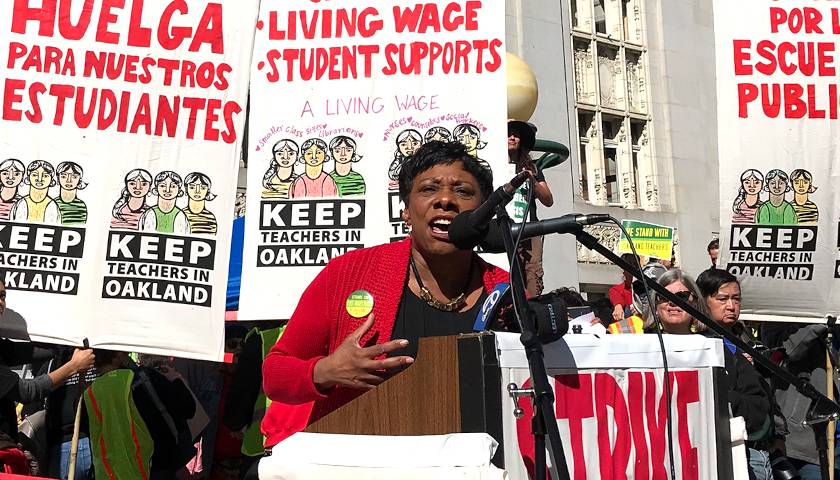by Kevin Killough
The Arizona Corporation Commission (ACC) recently took the unusual step of voting to pull back on the state’s renewable energy targets, over concerns they are too costly and produce few benefits.
Most states are moving in the other direction, following California’s lead, but there are signs of some hesitation as the real costs of these policies are realized.
California has pursued some of the most aggressive renewable energy policies in the U.S. Since 2008, wind and solar in California went from 3 percent of the state’s electricity generation mix to 25.7 percent last year. and it pays the third highest electricity rates in the county behind Hawaii and Rhode Island.
Meanwhile, the carbon intensity, a measure of carbon dioxide emissions per kilowatt hour generated, has remained unchanged since at least 2011. As more states see their electricity rates continue to rise with little in the way of benefits, Arizona may turn out to be an energy trendsetter. But the political momentum behind net-zero targets is preventing any full retreats.
Distorted market
In February, the Arizona Corporation Commission, which oversees the state’s utility services, voted 4-1 to direct staff to draft an order eliminating Arizona’s Renewable Energy Standard and Tariff (REST), which functions as the state’s Renewable Portfolio Standard (RPS).
RPS is a policy that directs utilities to generate a certain amount of electricity from sources that don’t produce carbon dioxide, such as wind and solar energy.
Twenty-nine states have adopted RPS’s, which apply to 58 percent of total U.S. retail electricity sales. Of those, according to a Berkeley Lab analysis, 16 have RPS targets of 50 percent of retail sales being from renewable sources, and 17 states have a 100 percent target.
Arizona’s REST was passed in 2006 when the ACC sought to aggressively reduce the state’s emissions levels from its electricity sector. It directed Arizona utilities to deliver at last 15 percent renewable energy by 2025. The utilities have already met or exceeded those standards, according to the ACC, but often at prices exceeding market price.
“We began the steps needed to repeal a rule that has cost ratepayers billions of dollars in out of market priced contracts. Mandates distort market signals and are not protective of ratepayers,” ACC Chairman Jim O’Connor said in a statement. According to the ACC, the renewable energy standards have added $2.3 billion to Arizona residents’ utility bills.
West Virginia repealed their RPS in 2015, and Montana repealed their RPS in 2021. Montana’s RPS targets had already been exceeded by the time it was repealed, and the legislature had no intention of setting new, more stringent targets.
Energy schizophrenia
While wind and solar are often reported as the cheapest forms of energy, that’s based on a flawed metric called levelized cost of energy, which doesn’t factor in all the costs associated with maintaining a reliable electricity supply using energy sources that only produce electricity according to largely random weather patterns.
Those hidden costs include overbuilding capacity, transmission lines, baseload backup, and energy storage. As more and more American ratepayers are discovering, rather than see their utility bills drop with increased wind and solar power as proponents promised, the exact opposite is happening.
Rather than reverse course, however, energy experts Mitch Rolling and Isaac Orr, policy fellows for the Center of the American Experiment and author of the “Energy Bad Boys“ Substack, say most states are trying to juggle the high rates while staying the course.
“States with wind and solar mandates are finally starting to feel the sticker shock of the misguided policies they have enacted, but the result has been a bout of schizophrenic policies that gyrate between scaling back their green ambitions and doubling down on them,” Orr told Just The News.
Orr points to what’s happening in New York as an example. The state set a goal of 70 percent renewable energy by 2030 and 100 percent by 2040. Politico reported that New York residents are paying an ever higher rate for their electricity, which is raising doubts about the state’s rapid net-zero targets.
“Proponents say the switch will ultimately lower energy bills by harnessing the sun and wind, result in significant health benefits and — critically — help stave off the most devastating climate change scenarios,” Politico reporter Marie French writes. Orr said New York is now trying to deal with the high costs of wind and solar energy, while remaining committed to a policy that adds more unreliable energy to the grid.
“On the one hand, New York canceled offshore wind leases due to cost, but the state also recently allowed offshore wind companies to nearly double the guaranteed price they could charge for electricity,” Orr wrote.
California is also displaying this same kind of “energy schizophrenia.” To minimize the impact of wind and solar costs on the lower income residents, the state is now socializing the cost of electricity by basing utility bills on income levels.
“That law is now under fire from lawmakers who have unhappy constituents,” Orr said.
Rolling told Just The News that there’s more signs of backtracking in California, such as its reform of solar net metering, which paid residents with rooftop solar for the electricity they provided to the grid when their panels were producing more than the home was consuming. The system was criticized for effectively making lower-income residents subsidize those who could afford homes and solar panels.
“California’s reform will effectively stop overpaying for residential solar generation and has already led to a significant drop in installations,” Rolling said.
Federal incentives
The Orange County Register published an editorial in March arguing that the state’s commitment to “unrealistic” climate goals is preventing the state from addressing problems with housing, transportation and energy.
However, even if the state did find the political will to repeal its climate goals, Orr and Rollings explain in “Energy Bad Boys” that utilities have incentives, thanks to federal subsidies, to remain committed to building out wind and solar. This means even in Republican states where lawmakers haven’t adopted RPS’s and defer to utilities on what Orr said is the mistaken impression that they’re private companies that will act in the best interest of their customers, there will be increasing wind and solar on the grid.
“In reality, they are government-approved monopolies. This leads utility companies to capitalize on this trust by building a lot of wind and solar and padding their rate bases. By the time conservative lawmakers have figured out what was happening with rates, on many occasions, it’s too late. The horse is out of the barn,” Orr said in an interview.
While state-level reform won’t reverse the federal incentives toward costly renewable energy policies, Rolling said there is a gradual retreat happening on the state level, which is promising.
“Slowly but surely, bad energy policies based on the climate movement are beginning to be rolled back, and while these are steps in the right direction, more will need to be done in order to reign in costs and make affordability and reliability the standard in energy policy once more,” Rolling said.
– – –
Kevin Killough is a reporter at Just the News.
Photo “Arizona Corporation Commissioners” by Arizona Corporation Commission.




